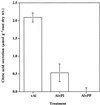Pattern of aluminum-induced secretion of organic acids differs between rye and wheat
- PMID: 10938369
- PMCID: PMC59110
- DOI: 10.1104/pp.123.4.1537
Pattern of aluminum-induced secretion of organic acids differs between rye and wheat
Abstract
Al-Induced secretion of organic acids from the roots has been considered as a mechanism of Al tolerance, but the processes leading to the secretion of organic acids are still unknown. In this study, the secretion pattern and alteration in the metabolism of organic acids under Al stress were examined in rye (Secale cereale L. cv King) and wheat (Triticum aestivum L. cv Atlas 66). Al induced rapid secretion of malate in the wheat, but a lag (6 and 10 h for malic and citric acids, respectively) between the exposure to Al and the secretion of organic acids was observed in the rye. The activities of isocitrate dehydrogenase, phosphoenolpyruvate carboxylase, and malate dehydrogenase were not affected by Al in either plant. The activity of citrate synthase was increased by the exposure to Al in the rye, but not in the wheat. The secretion of malate was not suppressed at low temperature in the wheat, but that of citrate was stopped in the rye. The Al-induced secretion of citrate from roots of the rye was inhibited by the inhibitors of a citrate carrier, which transports citrate from the mitochondria to the cytoplasm. All of these results suggest that alteration in the metabolism of organic acids is involved in the Al-induced secretion of organic acids in rye, but only activation of an anion channel seems to be responsible for the rapid secretion of malate in the wheat.
Figures





Similar articles
-
Al-induced efflux of organic acid anions is poorly associated with internal organic acid metabolism in triticale roots.J Exp Bot. 2003 Jul;54(388):1753-9. doi: 10.1093/jxb/erg188. Epub 2003 May 28. J Exp Bot. 2003. PMID: 12773523
-
Metabolic acclimation supports higher aluminium-induced secretion of citrate and malate in an aluminium-tolerant hybrid clone of Eucalyptus.BMC Plant Biol. 2021 Jan 6;21(1):14. doi: 10.1186/s12870-020-02788-4. BMC Plant Biol. 2021. PMID: 33407145 Free PMC article.
-
Root release and metabolism of organic acids in tea plants in response to phosphorus supply.J Plant Physiol. 2011 May 1;168(7):644-52. doi: 10.1016/j.jplph.2010.09.017. Epub 2011 Feb 18. J Plant Physiol. 2011. PMID: 21315475
-
Role of organic acids in detoxification of aluminum in higher plants.Plant Cell Physiol. 2000 Apr;41(4):383-90. doi: 10.1093/pcp/41.4.383. Plant Cell Physiol. 2000. PMID: 10845450 Review.
-
Mechanisms and regulation of aluminum-induced secretion of organic acid anions from plant roots.J Zhejiang Univ Sci B. 2019 Jun;20(6):513-527. doi: 10.1631/jzus.B1900188. J Zhejiang Univ Sci B. 2019. PMID: 31090277 Free PMC article. Review.
Cited by
-
Low Temperature Induced Changes in Citrate Metabolism in Ponkan (Citrus reticulata Blanco cv. Ponkan) Fruit during Maturation.PLoS One. 2016 Jun 1;11(6):e0156703. doi: 10.1371/journal.pone.0156703. eCollection 2016. PLoS One. 2016. PMID: 27249065 Free PMC article.
-
Identification of an ATP-Binding Cassette Transporter Implicated in Aluminum Tolerance in Wild Soybean (Glycine soja).Int J Mol Sci. 2021 Dec 9;22(24):13264. doi: 10.3390/ijms222413264. Int J Mol Sci. 2021. PMID: 34948067 Free PMC article.
-
A single-population GWAS identified AtMATE expression level polymorphism caused by promoter variants is associated with variation in aluminum tolerance in a local Arabidopsis population.Plant Direct. 2020 Aug 12;4(8):e00250. doi: 10.1002/pld3.250. eCollection 2020 Aug. Plant Direct. 2020. PMID: 32793853 Free PMC article.
-
Effects of polygalacturonase overexpression on pectin distribution in the elongation zones of roots under aluminium stress.AoB Plants. 2022 Feb 23;14(2):plac003. doi: 10.1093/aobpla/plac003. eCollection 2022 Apr. AoB Plants. 2022. PMID: 35356145 Free PMC article.
-
Evaluation of phosphate rock as the only source of phosphorus for the growth of tall and semi-dwarf durum wheat and rye plants using digital phenotyping.PeerJ. 2023 Aug 29;11:e15972. doi: 10.7717/peerj.15972. eCollection 2023. PeerJ. 2023. PMID: 37663276 Free PMC article.
References
-
- Aniol A, Gustafson JP. Chromosome location of genes controlling aluminum tolerance in wheat, rye and triticale. Can J Genet Cytol. 1984;26:701–705.
-
- Aniol A, Hill RD, Larter EN. Aluminum tolerance of spring inbred lines. Crop Sci. 1980;20:205–208.
-
- Basu U, Godbold D, Taylor GJ. Aluminum resistance in Triticum aestivum L. associated with enhanced exudation of malate. J Plant Physiol. 1994;144:747–753.
-
- Bradford MM. A rapid and sensitive methods for the quantitation of microgram of proteins utilizing the principle of protein-dye-binding. Anal Biochem. 1976;72:248–254. - PubMed
-
- de la Fuente JM, Ramirez-Rodriguez V, Cabrera-Ponce JL, Herrera-Estrella L. Aluminum tolerance in transgenic plants by alteration of citrate synthesis. Science. 1997;276:1566–1568. - PubMed
Publication types
MeSH terms
Substances
LinkOut - more resources
Full Text Sources

